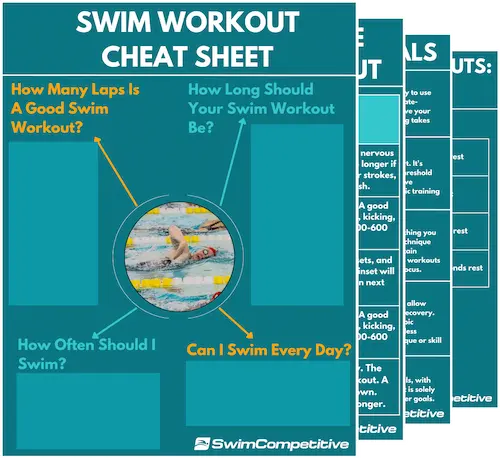When you think of a swimmer’s body, you might imagine the tall, broad, and lean physique of a screaming Michael Phelps after the 4x100m freestyle relay as he claims his second gold medal of the Beijing Olympics in world-record time.
And while it’s undoubtedly true that the swimmer’s body is often regarded as the embodiment of peak physical performance– chiseled and toned into athletic perfection through countless hours of training, you might wonder if it’s feasible for you, too, to achieve this iconic look.
So whether you are a competitive swimmer wondering if you have what it takes to reach the elite level or an everyday fitness enthusiast curious about how your physique and appearance might change with a training regime structured around swimming, all your questions will be answered in this article.
What’s more– I’ll cover the key characteristics of a swimmer’s body and provide actionable tips and insights to help you achieve this physique– and the physical performance that comes with it.
What Is a Swimmer’s Body?
A swimmer’s body is the physique developed through regular swimming and dryland training. Typical traits include a lean, toned physique with broad shoulders, large lats, defined arms and abs, and strong legs. Other common and largely genetic attributes include above-average height, a long torso and arms, and large hands and feet.
That said, it’s more than just the visual. The swimmer’s body is also known for its qualities of strength, fitness, and flexibility.
That said, I encourage you not to focus purely on how the swimmer’s body looks. Swimming is a great sport with many health benefits. It’s also an excellent way to meet interesting people and make lifelong friends. Not just that, but the life lessons learned along the journey will help you in many aspects of your life.
Natural Selection: Are You Born with a Swimmer’s Body or Is It Something You Can Develop?
Nobody is born with a swimmer’s body. You may be born with certain genetic qualities that allow you to swim faster and thus excel at the sport of swimming, making you more likely to stick with it and develop a swimmer’s body later on.
Traits like:
- Being tall
- Having a long torso and arms
- Short legs
- Large hands and feet
Over my years of competitive swimming, I have seen many swimmer’s with the typical traits of a swimmer’s body, such as broad shoulders, large lats, defined arms, and a lean physique, who didn’t possess all or any of the genetic traits mentioned above.
Yet, it would be ignorant to say that these swimmers didn’t have swimmers’ bodies due to the lack of a few genetic traits outside of their control.
On top of that, many of them were still able to excel at the sport, racking up local and national records and podium positions.
In short, a swimmer’s body can be developed by anyone willing to put in the hours in the pool and gym. You may not possess all (or any) of the genetic qualities typically associated with the stereotypical idea of a swimmer’s body, such as height. Still, you can develop many other attributes, such as broad shoulders, large lats, and a toned physique.
To further elaborate, even at the professional level, not all swimmers have every single genetic trait associated with a swimmer’s body.
Most swimmers will have a few of these characteristics. Typically, this would include being tall and having long limbs.
Still, they might lack other qualities, such as being hypermobile or having ideal body proportions like a long torso with short legs.
Yes, some of the greats like Michael Phelps had essentially all of the traits, but it’s not the only determining factor for success in the water.
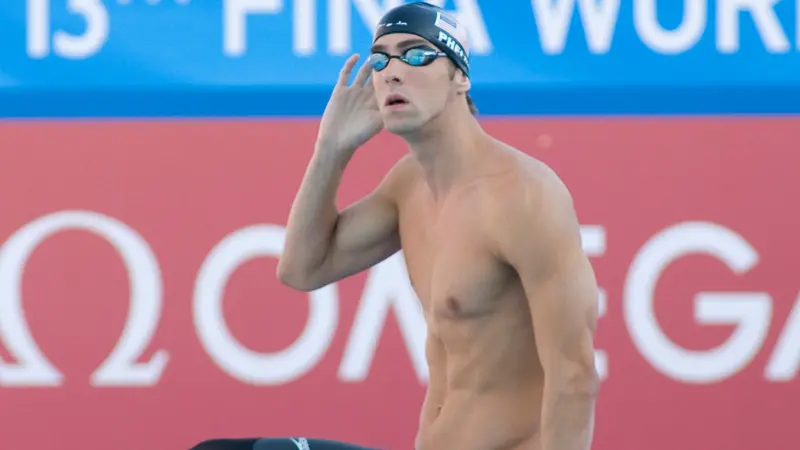
Like many of these elite swimmers, you might have one or two of these genetic traits, but not all of them.
At the end of the day, you are dealt a deck of cards. The dealing is unfair, but you have to play them to the best of your ability.
Key Elements of a Swimmer’s Body That Are in Your Control
When it comes to building a swimmer’s body, there are three main categories of elements that are in your control. These can help you not only shape a swimmer’s body but also achieve peak performance in the pool.
This includes:
- Having a high strength-to-mass ratio.
- A strong core.
- Being mobile and flexible.
Swimmers Have a High Strength-To-Mass Ratio
A high strength-to-mass ratio encompasses having good musculature combined with low body fat.
This not only allows for the notorious lean look of the swimmer’s body, but more importantly, it allows swimmers to swim as fast as possible.
Being able to generate as much velocity as possible while keeping drag to a minimum is a critical component of swimming fast.
It’s also one of the reasons swimmers will pay hundreds of dollars for tech suits, which are special swimsuits designed to reduce drag and connect muscles for better power output.
Swimmers don’t want to look or train like bodybuilders since too much muscle isn’t helpful either– it creates more drag and causes you to tire faster.
That said, the amount of muscle can vary. Sprinters typically have the most muscle, while distance swimmers have the least.
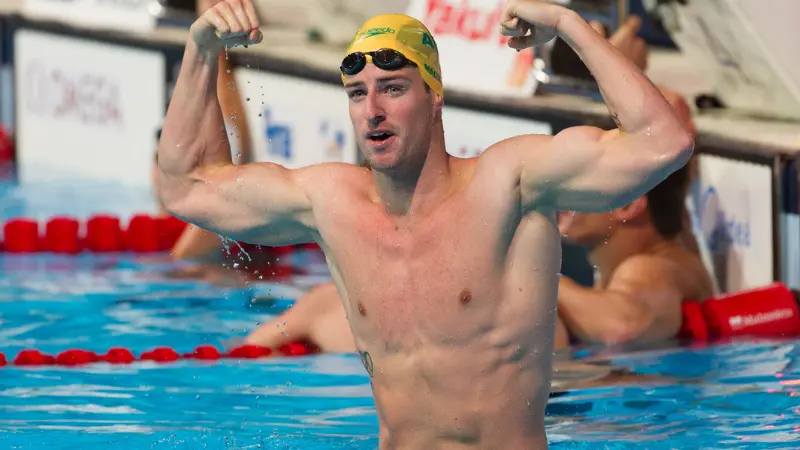
The good thing is that a high strength-to-mass ratio is in your control and can be developed through training and correct nutrition.
To achieve it, swimming alone won’t be enough. This is because, although swimming can build some muscle and strength, it’s not nearly as effective as incorporating dryland strength training. You’ll likely plateau in terms of muscle and strength gains after a few months.
Therefore, to develop the necessary musculature and strength, I recommend adding strength training to your routine.
Here are some articles that you can consider reading if you’d like to learn more about these topics:
- Swimming and weight training guide
- Arm exercises for swimmers
- Upper body exercises for swimmers
- Leg exercises for swimmers
- Strength exercises for swimmers
- Resistance band exercises for swimmers
- Dryland exercises for swimmers
You’ll also have to combine this with good dietary habits to ensure that you can build strength and muscle during hard training phases. Later on, you can cut down and focus on reaching a lower level of body fat.
If you’d like to learn to do this effectively, I recommend reading my article on how to create a meal plan for swimmers.
A Strong Core Is Critical for a Well-Rounded Swimmer’s Body
As mentioned, abs are a key characteristic of a swimmer’s body. And while the core does encompass the abs, it also includes muscles around your pelvis, lower back, and hips.
The core muscles are critical for developing a swimmer’s body and being able to swim fast. Some of their benefits include:
- Linking your upper and lower body to move through the water like a torpedo.
- Improving your body position in the water to reduce drag.
- Enhancing balance and stability while swimming.
- Allowing for effective underwaters and kicking.
Similar to achieving a high strength-to-mass ratio, a strong core can be developed using dryland exercises. Swimming will also naturally strengthen your core, but I recommend supplementing with additional exercises outside of the pool for maximum results.
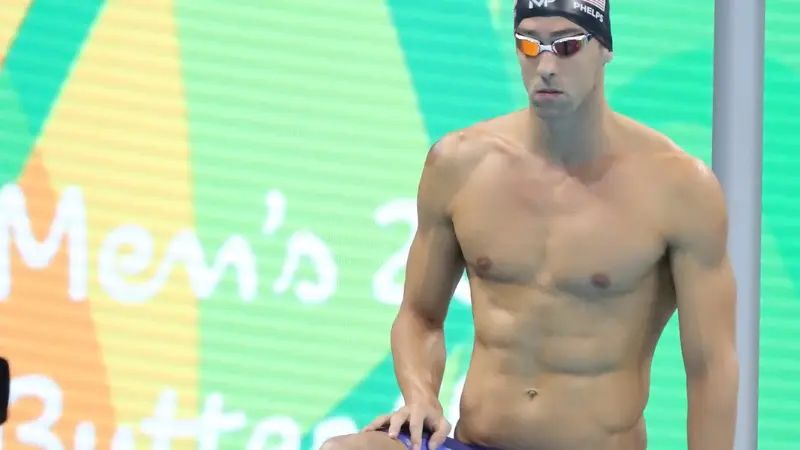
Swimmers Have to Be Mobile and Flexible
Being flexible and mobile is essential to being a good swimmer and achieving the swimmer’s body. Although this isn’t as visual a component, it’s still very important and necessary.
Swimming requires good mobility to achieve correct technique in the water and master specific skills like underwater dolphin kicks, starts, and turns.
Without adequate flexibility, your swimming technique will lack in many regards, and you’ll have a hard time getting into certain positions.
You’ll also be at far greater risk of injury.
Generally, swimmers should be flexible all around. This allows you to be a better athlete and minimize your overall risk of injury.
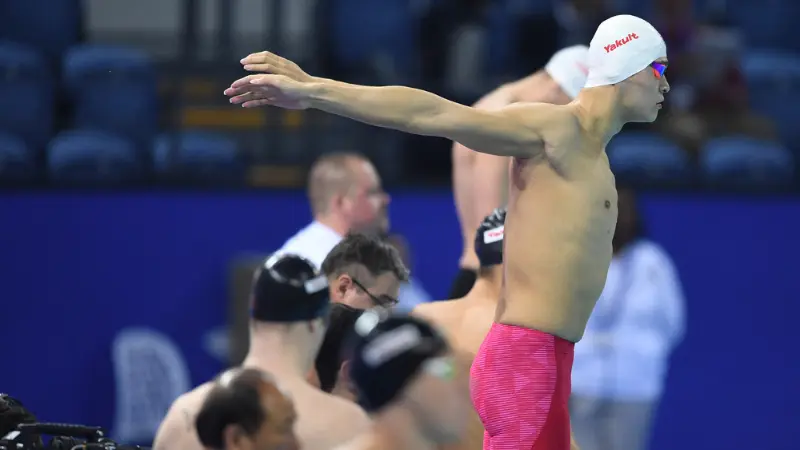
That said, there are three critical areas of the body where swimmers require flexibility. This includes:
- The upper back
- Shoulders
- Ankles
A flexible upper back and shoulders allow you to effectively utilize your upper body for an efficient stroke and generate maximum speed.
For example, the rotational movement of the arms during freestyle and backstroke, the undulation during butterfly, or the lunge in breaststroke.
Flexible ankles are also crucial for a powerful kick since they allow your feet to act as a flipper and propel you forward in strokes like freestyle, backstroke, and butterfly. In breaststroke, flexible ankles are required to help your feet grab onto the water and execute an efficient kick.
Both the kick and arm stroke are crucial, although there may be some differences in propulsion depending on the stroke.
One study published by the BioMed Research Journal found that during long-axis strokes like freestyle, the leg kick contributed an average of 31% to the generated velocity, while the arms contributed the remaining 69% of velocity.
In short-axis strokes, the ratios are different, with the kick contributing upwards of 70% of the velocity depending on the stroke.
Similar to developing a high strength-to-mass ratio and a strong core, flexibility is also something that you can train and improve through regular stretching and mobility exercises.
There are undoubtedly genetic limitations to flexibility, but by incorporating stretching and mobility exercises, you can develop the flexibility required to be a good swimmer.
Characteristics of a Swimmer’s Body That Are Out of Your Control
These factors are predominantly genetic. They can be advantageous in achieving a swimmer’s body and reaching peak performance in the water.
There isn’t any point in fixating on the traits you lack. There’s nothing you can do to change the fact that you were born without them.
Instead, focus on the things that are in your control. It’s still possible to reach a high level in the sport, even with a lack of these qualities.
Height and Limb Length: Being Tall Is an Advantage
It’s no secret that elite-level swimmers are tall.
During the Rio Olympics, the average height of Olympic finalists stood at 6’2” (1.88m) for males and 5’9” (1.75m) for females.
Across all Olympics, height is a prominent trait for swimmers. Have a look at the average height per event for the London Olympics:
| Average Height of Lodon Olympic Finalists | Men | Women |
| 50 Freestyle | 6’4″ (1.93m) | 5’10” (1.78m) |
| 100 Backstroke | 6’2″ (1.88m) | 5’10” (1.78m) |
| 100 Butterfly | 6’2″ (1.88m) | 5’11” (1.80m) |
| 200 Breaststroke | 6’1″ (1.85m) | 5’8.5″ (1.74m) |
| 200 Butterfly | 6’1.5″ (1.86m) | 5’8″ (1.72m) |
| 400 Freestyle | 6’2″ (1.88m) | 5’11” (1.80m) |
| 400 IM | 6’0″ (1.83m) | 5’7″ (1.70m) |
It’s also no surprise to see some of the big names in the sport towering at above-average height:
- Micheal Phelps: 6’4”/ 1.93m
- Nathan Adrian: 6’6” / 1.98m
- Adam Peaty: 6’3” / 1.91m
- Chad le Clos: 6’1” / 1.86m
- Caeleb Dressel: 6’3” / 1.91m
- Ryan Lochte: 6’2” / 1.88m
- Sarah Sjostrom: 5’11” / 1.82m
- Katie Ledecky: 6’ / 1.83m
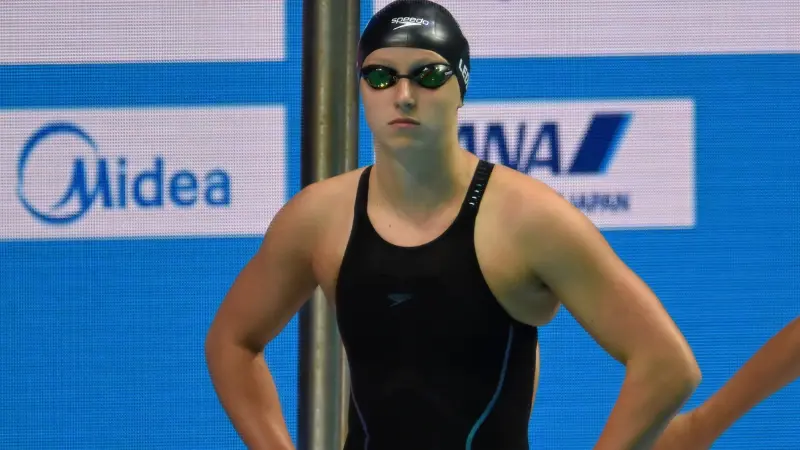
Since height provides an advantage in the pool, it’s only natural that so many elite swimmers are also tall, which explains why the trait is typically associated with the swimmer’s body.
That said, you might be wondering how height provides an advantage. Well, it turns out it has a lot to do with physics. The taller you are, the less wave drag you experience. Being tall can reduce your wave drag by up to 40% compared to shorter swimmers.
Being tall also means you likely have long arms and big hands and feet. This allows you to grab more water when kicking and pulling, increasing your swimming speed. Long arms will also help with your distance per stroke.
One study published in the Journal of Human Kinetics found that height and body fat percentage were significant predictors of the propulsive force of the arm movement during swimming.
In conclusion, the propulsive force of swimmers was related to body height and percent body fat.
– Journal of Human Kinetics
That said, there are still many examples of short swimmers competing at the elite level. Distance events also tend to favor slightly shorter swimmers.
Do You Want to Make Every Lap Count?
Stop wasting your time in the pool feeling lost and doing directionless swim workouts, and start training effectively! Our ebook contains 97 structured and goal-orientated swim workouts to help you become a better, faster, and fitter swimmer. Whether you’re a complete beginner or a seasoned pro, there are a multitude of workouts for every type of swimmer.
Aquatic Body Proportions: Long Torso, Short Legs, Wingspan, and Lung Size
Although height is a clear advantage, other physical factors can also be beneficial to fast swimming and are often associated with a swimmer’s body.
A good example is having a long torso with short legs. This is related to your body proportions. You don’t necessarily have to be a towering giant to possess these traits.
A long torso is advantageous since it causes the swimmer’s center of mass to sit closer to the lungs. This allows the swimmer to float effortlessly on top of the water, ensuring a better body position and reducing drag.
A long torso could also facilitate larger lungs. That said, it’s not to say just because you have a long torso that, your lung size is above average.
Large lungs can provide more oxygen to muscles, helping to enhance swimming performance. It’s not only beneficial during competition but also during training. An above-average lung size means swimmers can train harder for longer.
On the other hand, short legs allow for a powerful kick while keeping drag to a minimum.
A proportionally long wingspan is another advantageous trait. An average wingspan is the same length as the overall height of your body, but having a longer wingspan than this can help you pull more water and increase your distance per stroke.
For example, Michael Phelps had a wingspan of 6’7” (2m), while his height was only 6’4” (1.93m).
Hypermobility for Increased Propulsion
Hypermobility, commonly known as being double-jointed, refers to individuals with a greater range of motion in their joints than average.
In swimming, this allows them to bend certain body parts further backward. This can be advantageous for generating propulsion since swimmers can grab and push more water with each stroke and kick.
That said, although hypermobility can be an advantage in swimming, it can also be a disadvantage. Hypermobility can increase the risk of joint instability, dislocation, and injury during training. That said, keeping your muscles strong is a crucial way to combat injuries of this nature.
How to Get a Swimmer’s Body: Developing the Characteristics That Are in Your Control
Now that we’ve discussed some of the key components of a swimmer’s body let’s see how you can develop it for yourself.
You Have to Swim– a Lot
If you want to achieve the notorious look of a swimmer’s body, you have to swim– there is simply no way around it.
Elite swimmers log anywhere from 9-12 sessions in the pool each week.
Swimming will be primarily responsible for developing the distinctive frame of a swimmer’s body. This includes:
- Broad shoulders and large lats: The endless repetitions of the arm stroke in swimming shapes these muscles into the well-defined V-shape that so many swimmers possess.
- Lean and defined muscles: Swimmers benefit from being muscular but not overly bulky, as this can cause drag. Swimming is a cardio activity that burns many calories and reduces muscle-building effects, resulting in lean muscles and low body fat.
- Abs: The core muscles are constantly engaged when swimming, and swimmers often have low body fat, causing the abs to be a prominent feature.
- Strong Pectoral Muscles: The chest is frequently engaged when pulling, leaving swimmers with broad and muscular chests.
- Strong legs: The legs are essential in swimming, not only for a powerful kick but also for starts, turns, and underwaters. As a result, swimmers have strong and well-defined legs that aren’t overly bulky.
- Arms: Likewise with developing broad shoulders, large lats, and a muscular chest, the repetitive pulling motion of swimming provides swimmers with well-defined arms as well, especially the tricep muscles.
See swimming as laying the groundwork for the swimmer’s body (duh!). That said, other factors outside of the water also play into achieving a swimmer’s body and maximizing your performance in the water.
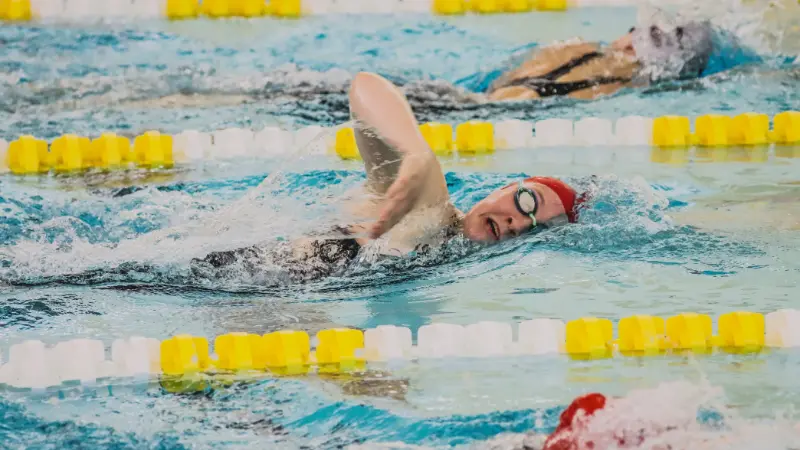
Add Dryland Training to Your Routine
Think about it this way, the swimmer’s body is built in the pool and sculpted in the gym.
Dryland training is an important aspect of achieving a swimmer’s body and maximizing your performance in the water.
Although swimming can build muscle, this is often limited.
Swimmers have to fall back on gym work and strength training to shape their bodies further, improve strength and performance, and minimize their risk of injuries in the water.
It’s essential to follow a well-structured dryland program optimized for swimmers. Your focus should be primarily on developing strength and not building muscle. As mentioned, becoming overly bulky is not an advantage for swimming.
That said, the amount of muscle you have will also depend on the events you swim. If you are a sprinter, more muscle can be beneficial, while if you swim, long-distance less muscle is better.
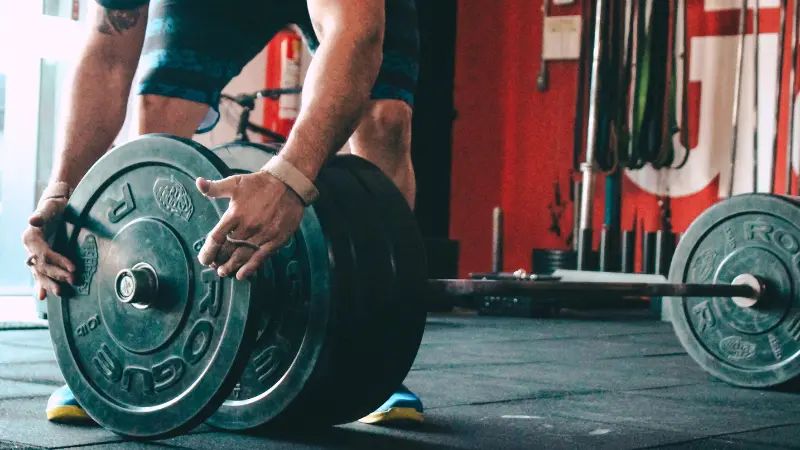
Nutrition Is Important for Building a Swimmer’s Body
Training hard in the pool and gym is all good and well, but having the correct nutrition is just as, if not even more, important.
By optimizing your nutrition, you will be able to ensure that you are effectively recovering, becoming stronger, and leaning down as the competition season approaches.
It’s often best to be in a caloric surplus during hard training phases since this will allow you to train hard, recover well, become stronger, and add muscle (if that’s the goal).
During the racing season, it’s a good idea to adjust your diet to lean down. If you trained properly during the off-season, you will now have a higher strength-to-mass ratio and can swim fast and hit new personal best times in the pool.
Related:

How Long Does It Take to Get a Swimmer’s Body?
Developing a swimmer’s body takes many years. It is often achieved by individuals who start swimming early in their lives. Sculpting the swimmer’s body takes thousands of repetitions in the pool for muscles to develop their distinctive shape. It will also depend on how much you swim. If you swim a lot, it will take less time than if you swim less.
Related: How does swimming change your body?
Problems That Can Develop with a Swimmer’s Body
Unfortunately, there are also some problems associated with the swimmer’s body.
Poor Posture: “Swimmer’s Slouch”
Swimmers frequently have rounded shoulders with a hunched back and a head that tilts downwards. The pelvis is often also tilted slightly back.
This poor posture is due to the repetitive nature of swimming, which causes muscle imbalances in the chest, upper back, neck, and quadriceps, aligning the body in an unnatural way.
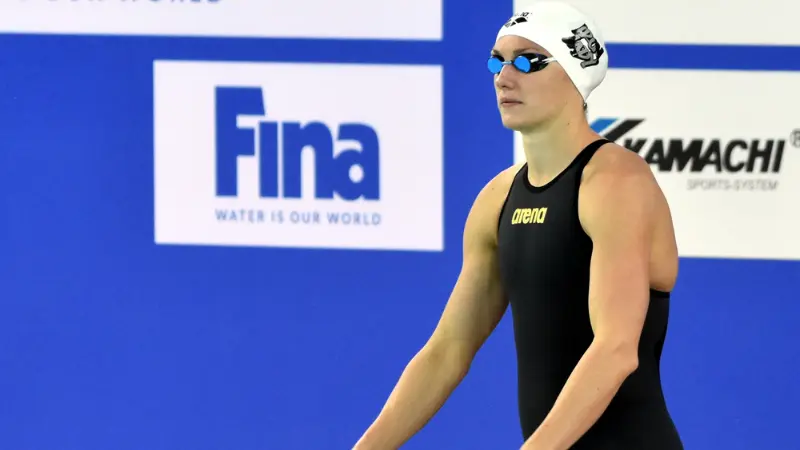
This puts you at risk of injuries and can cause back and shoulder pain.
Luckily, this poor posture can easily be counteracted by adding dryland exercises that focus on strengthening your posterior chain (the back of your body) and increasing flexibility in the thoracic spine.
Example exercises can include:
- Banded rows
- Dumbbell rows
- Cable face-pulls
- Band pull aparts
- Wall Angels
- Deadlifts
- Romanian deadlifts
- Hip Thrusts
- Hamstring curls
- Glute bridges
- Thoracic extensions on a foam roller
- Cat-camel stretch
- Lying windmill stretch
Another good way to combat swimmer’s posture is by swimming more backstroke during practice. Unlike the other strokes, backstroke opens the chest while simultaneously engaging a large portion of the posterior chain.
Loose Ankles
As mentioned, ankle flexibility is an advantageous trait in the pool. It often develops naturally due to the thousands of kicking repetitions in the water.
Unfortunately, loose ankles outside of the water can be a problem. Moving on uneven surfaces, running, and landing from jumping movements can result in a sprained ankle.
Luckily, this too can be treated through a variety of exercises to strengthen your ankles.
Becoming Elite: Being a Good Swimmer Is About More Than Just Your Body
I’m not here to tell you that it’s all fairy tales and butterflies and that you can do and be whatever you want.
Yes, life is unfair. Yes, some people are naturally more talented than you. Yes, your body does play a role in how fast you can swim.
At the end of the day, we all have limits. But I can promise you this– whatever you think those limits are, those boundaries of what you can achieve, you are capable of so much more.
Nobody knows what their limits are and what they can achieve. But you can try– and without trying, you’ll never know whether you can or not.
Whether you think you can or think you can’t. You’re right.
– Henry Ford
Very few swimmers will ever make it to the professional level. But if that’s your goal, you shouldn’t let anything stop you from trying.
More often than not, fulfillment comes through the process of chasing your goals, not achieving them.
And even if you never reach the elite level– that’s okay– as long as you know that you gave it your all.
The lessons you learn, experiences you gather, the friends you make, and the health benefits you gain along the way are far more valuable than any gold medal will ever be.
Make sure to enjoy the sport for what it is and to have fun. It won’t always be easy, but in the end, it’ll be worth it.
Getting a Swimmer’s Body Is Hard Work!
Building a swimmer’s body is not for the faint of heart. It will take many months and years of training in the pool and gym to achieve. There will be setbacks and times when things don’t go to plan.
My advice is simple: if you want a swimmer’s body, you need to fall in love with the sport of swimming.
Join a club, get coaching, and ensure you are doing all the fundamentals right– swimming, dryland, and nutrition. Before you know it, you’ll not only be walking around with shoulders the width of a doorway, but you’ll be fitter and healthier than you’ve ever been.
And who knows– maybe you win a few medals and break a couple of records along the way.
